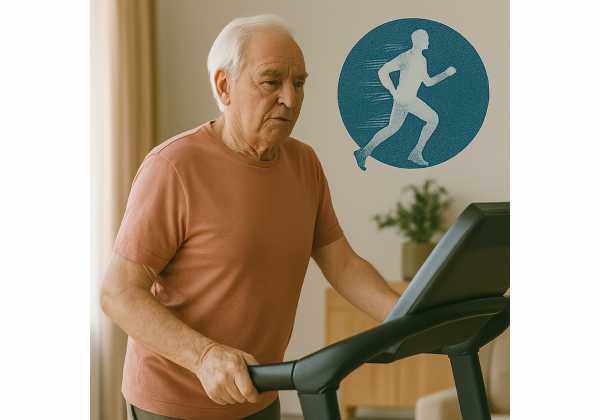
How you move says a lot about how you think. Walking speed, turning smoothness, and the split second it takes to react to a cue are windows into attention, planning, and brain resilience. Subtle slowdowns often appear years before big changes in memory or daily function. The goal of this guide is practical: explain why these signals matter, show you simple tests you can repeat at home, and outline ways to train safely so your pace, balance, and confidence improve together. You will also learn when a change is noise—and when it deserves a medical evaluation. If you are building a broader plan for lifelong brain health, pair these steps with our core brain-health framework. Read, pick two quick measurements to start, and give yourself a month of steady practice. Small habits compound into steadier walking, faster decisions, and fewer close calls.
Table of Contents
- What Slow Gait and Delayed Reaction Can Reveal About the Brain
- Simple Tests You Can Do at Home (and How to Repeat Them)
- Attention, Executive Function, and Walking Complexity
- Training Ideas: Cues, Obstacle Courses, and Short Bursts
- Falls and Safety: When to Seek Assessment
- Building a Monthly Check-In: Pace, Turns, and Balance
- When Changes Suggest a Medical Evaluation
What Slow Gait and Delayed Reaction Can Reveal About the Brain
Gait is a moving symphony: vision scans the environment, the inner ear stabilizes your head, the spinal cord coordinates patterns, and the frontal lobes set pace and priorities. When that system runs well, your steps stay even while you talk, plan, or carry a bag. When it strains, the first hints are quiet—shorter steps, hesitations at turns, or a longer beat between a cue and your response. These are not only “leg issues.” They often reflect how the brain allocates attention under pressure.
Two patterns are especially informative. The first is usual gait speed—your comfortable pace on level ground. It integrates strength, sensation, and executive control. Across aging, very gradual changes are expected. What matters most is slope (the rate of change) rather than a one-time number. A steady, noticeable slowdown across months—especially if paired with new forgetfulness or trouble multitasking—can signal stress on the same fronto-subcortical networks that manage attention and planning.
The second pattern is dual-task cost—how much you slow when you add a mental task to walking. For many, conversation barely dents pace. For others, talking and walking together leads to shorter steps, wobblier turns, and lost words. That gap between “walk alone” and “walk while thinking” is where fall risk and cognitive strain often show up. Training can narrow this gap by teaching your brain to share resources more efficiently.
Reaction time is a related clue. Life is full of split-second choices: a bike bell behind you, a pet at your feet, a curb that comes sooner than expected. If you feel slow to start, stop, or sidestep—especially in busy or noisy settings—your processing speed may be taxed. The good news: processing speed is trainable. Short drills that pair simple movements with clear cues (stop/go, left/right, name a category) can sharpen the loop from perception to action.
Why do these movement signals map to thinking? They share infrastructure. Executive functions—shifting tasks, inhibiting distractions, updating a plan—sit in the same circuits that help you manage complex walking. Vascular health, sleep quality, vision, hearing, and medication side effects all influence these circuits. That is why a small change in your walk can be a useful early prompt to check the basics: glasses, lighting, sleep, blood pressure, and drug interactions that sap attention or balance.
The takeaway: movement is not just mobility. It is a daily report from the brain’s planning and prioritizing systems. Learn how to read it, and you can act early, train smarter, and move more confidently.
Simple Tests You Can Do at Home (and How to Repeat Them)
Testing at home should be simple, safe, and repeatable. Use the same shoes, hallway, and time of day each time you measure. Record results in a small notebook or notes app.
1) Ten-Meter Walk (comfortable pace)
- Setup: Mark a 14-meter path with tape. The middle 10 meters is your timing zone; the first and last 2 meters allow you to speed up and slow down safely.
- How: Walk at your usual pace, start timing at the 2-meter mark, stop timing at 12 meters. Repeat twice; record the average time.
- What to look for: Stable times across months. A consistent, gradual slowdown or a new unevenness (short steps, arm swing disappears) deserves attention.
2) Thirty-Second Sit-to-Stand
- Setup: Use a standard-height chair against a wall. Arms crossed at the chest.
- How: Count how many full stands you complete in 30 seconds without using your hands.
- Why it matters: Leg strength and rhythm support safe walking and turning.
3) Dual-Task Walk
- Setup: Use the same 10-meter timing zone.
- How: Walk at your usual pace while naming animals, tools, or cities out loud. Time the 10 meters and count correct words.
- Dual-task cost (optional): Compare this time to your single-task time. A large gap suggests you rely heavily on attention to keep gait steady—good to know and train.
4) Turn Test (figure-eights)
- Setup: Place a mug or cone on the floor.
- How: Walk a slow figure-eight around it twice, keeping steps smooth. Count stumbles or missteps.
- Why: Turns reveal how your brain updates plans mid-movement.
5) Simple Reaction Drill
- Setup: In a clear hallway, ask a partner to call “red” (stop), “green” (go), or “yellow” (slow). If you are solo, play a song: stop at any chorus, go during verses.
- How: Walk 10 meters, respond to three to five random cues, and note any late stops or off-balance moments.
Testing cadence and rules
- Frequency: Check once weekly for the first month, then monthly.
- Consistency: Same route, same shoes, similar time of day, similar lighting.
- Safety: If you ever feel unsteady, add a light touch to a counter or rail and reduce difficulty.
Logging and interpretation
- Write down distance, time, number of words, and any stumbles.
- Trends matter more than single scores. Look for progress in two places: a slightly faster comfortable pace or fewer errors at the same pace.
- If you struggle to see in dim light or to read your floor markings, tune your environment first; clear contrast and even light can improve both testing and daily walking. For practical options, see how to optimize lighting and lenses at home.
These home tests are not diagnoses. They are early warning lights and training targets. When you track them, you can celebrate gains and catch concerning changes sooner.
Attention, Executive Function, and Walking Complexity
Walking is usually automatic. Complexity begins when the world adds demands: a curb, a question, a turn, a leash that tangles at your feet. In those moments, executive functions set priorities: keep balance, answer briefly, slow at the curb, glance for traffic, then speed up. If executive control is stretched thin, one of those steps lags—often gait stability or conversation fluency.
Three executive skills are central:
- Shifting: switching between tasks (talking and scanning the street). You see this when someone pauses mid-sentence to step off a bus safely, then resumes speaking without a stumble.
- Inhibition: blocking distractions (ignoring a passing noise to finish a step). This keeps foot placement precise despite a sudden sound or a phone buzz.
- Updating: refreshing working memory (remembering which street to turn onto while managing a rolling suitcase).
When these skills waver, the dual-task cost goes up. The gap between “walk alone” and “walk while thinking” widens. Training aims to reduce that gap, not by forcing multitasking, but by improving task sharing. You learn when to prioritize stability (pause speech during a tricky turn) and when to re-engage conversation. Over time, your brain becomes more efficient at switching without losing posture or pace.
What drives executive strain? Common culprits include poor sleep, low mood, high stress, pain, vision or hearing changes, and medications that dull alertness. Vascular factors—blood pressure, glucose variability—also matter because they affect the white-matter “wiring” that connects frontal control areas to movement circuits. Targeted training helps, but so does tending to these basics.
Useful rules for complex walking:
- Corners are cognitive. Treat turns like mini-tasks: eyes first, then feet. It is fine to pause speech during a tight pivot.
- One decision per step. If you must solve something tricky (finding the right entrance), stop briefly, decide, then move.
- Partner cues help. Agree with a walking partner that they will pause conversation at curbs and resume after you clear them.
Practice builds cognitive reserve—extra capacity and flexible routing that helps the brain cope with age-related changes. If you want a deeper, plain-language overview of how learning changes the brain and buffers everyday function, see our explainer on cognitive reserve.
The bigger picture: you are not training to “walk and do math.” You are training to navigate real life without losing your footing—literally and figuratively.
Training Ideas: Cues, Obstacle Courses, and Short Bursts
Start with short, predictable drills. Then add small twists—unexpected cues, soft obstacles, alternating tasks. The goals are steadier pace, smoother turns, and quicker, calmer reactions.
Warm-up (3 minutes)
- Easy hallway walk, gentle head turns (eyes open), shoulder rolls.
- Two slow sit-to-stands to wake up leg and core muscles.
Block A: Walk-and-name (2–3 rounds)
- Walk 10–15 meters while naming fruits, tools, or birds. Keep posture tall and steps even.
- Round 2: alternate categories (fruit, tool, fruit, tool).
- Round 3: count backward by 3s at a comfortable pace.
Block B: Turns and task-switching (2 rounds)
- Place two mugs 3–4 meters apart; walk a figure-eight around them. At each mug, switch tasks (from naming animals to counting back by 4s).
- Focus on smooth pivots. If speech collapses, simplify the mental task or widen turns.
Block C: Obstacle awareness (2 rounds)
- Place two soft items (rolled towels) on the floor. Step over them while answering simple addition (6+7, 8+5).
- If toes clip, lower the obstacle and slow the pace.
Reaction finisher (2–3 minutes)
- Partner calls “red/yellow/green” while you walk; you stop, slow, or go. If solo, clap your hands randomly and use the sound as the cue.
- Add one memory element: remember the last two colors and repeat them at the end.
Cool-down (2 minutes)
- Slow walk, deep exhale focus, quick scan: “How was balance? Any stumbles? How did thinking feel?”
Progressions (raise one dial at a time)
- Pace: walk ~5–10% faster, same mental task.
- Complexity: upgrade categories to alternating letters and numbers (A-1, B-2…).
- Unpredictability: partner adds a “reverse” cue or a sudden left/right turn request.
Weekly rhythm
- Two focused sessions (20–30 minutes) plus two “snack” sessions (10 minutes) built into walks.
- After any tough day, schedule an easier one to consolidate.
If you enjoy structure and want more ways to combine thinking with movement, you may appreciate our structured dual-task playbook with additional drill ideas. Keep sessions short and satisfying. Success is when you finish wanting one more round.
Falls and Safety: When to Seek Assessment
Safety is the foundation for progress. Good training challenges you without flirting with a fall. Use these guardrails as you build capacity.
Set up a safe lane
- Clear a 3–5 meter path. Remove loose rugs and cords.
- Bright, even lighting; avoid glare on glossy floors.
- Keep a countertop within reach for light support during new drills.
- Wear closed-heel, non-slip shoes. Avoid backless slippers and thick, squishy soles that wobble on turns.
When to modify or pause
- New dizziness, blurred or double vision, chest pain, or breathlessness that does not settle with rest.
- Recent fall (past 3 months) or multiple near-falls.
- Foot pain or numbness that changes your step.
- Medications that make you drowsy or lightheaded soon after a dose.
Partner wisely
- Early sessions are smoother with a spotter. Ask them to walk slightly behind and to the side.
- Agree on a “quiet” protocol for curbs and turns (pause conversation, then resume).
Home hazards that masquerade as “bad balance”
- Dim hallways (fix with brighter bulbs and better contrast).
- Clutter at corners and doorways (clear visual lanes).
- Poorly fitting lenses or outdated prescriptions (update vision).
- Background noise that overwhelms hearing (turn down or use aids).
If dizziness, motion sensitivity, or “the room moves when I turn” are frequent themes, consider screening your inner ear and balance systems. A brief primer on vestibular basics explains common causes and what evaluation involves.
When to seek professional assessment
- Two or more falls in a year, or one fall with injury.
- A near-fall that you could not stop without grabbing furniture.
- Sudden changes in walking after an illness, new medication, or poor sleep.
- A growing fear of walking outside that shrinks your world.
A clinician or physical therapist can check strength, sensation, vestibular function, footwear, and medications. The right tweaks—vision, orthotics, device selection, targeted exercises—turn a precarious situation into steady improvement.
Building a Monthly Check-In: Pace, Turns, and Balance
A monthly check-in keeps small changes visible and progress honest. Think of it as a 15-minute appointment with yourself. Use the same checklist each time for clean comparisons.
Your three-item core
- Usual pace: two timed 10-meter walks; record the average.
- Dual-task pace: one 10-meter walk while naming a category; record time and words.
- Turns and obstacles: two figure-eights and six low obstacle steps; record missteps or toe taps.
Add one “capacity” measure
- Sit-to-stand 30 seconds or a brief unilateral balance check near a counter (light fingertip touch if needed). Consistency is more important than difficulty.
Note the context
- Sleep quality last night, pain level, new medications, and whether you walked before testing. These explain good and bad days and prevent overreaction to a one-off dip.
How to read trends
- Look at four-week blocks, not single days. Genuine change shows up in direction (steadily faster, steadier, or smoother) and variance (fewer wobbly days).
- An improving pattern: the dual-task time inches closer to your single-task time while word rate stays the same or improves.
- A caution pattern: both speed and word rate drop together, or missteps rise across two consecutive months.
If the curve stalls
- Change one variable: simplify the mental task, shorten the path, or slow the pace for a week to consolidate. Then rebuild.
- Rotate drills to avoid boredom: swap category naming for countbacks, or replace obstacles with start-stop cues.
Celebrate and bank the wins
- Keep one photo or one sentence each month about a real-life carryover—steady steps at a busy crosswalk, a smoother turn in the kitchen, or a walk-and-talk with a friend that felt easy. These moments reinforce your “why.”
Because learning is plastic, not fixed, your gains can stick and grow with repetition. If you enjoy the science behind practice schedules, visit our note on neuroplasticity windows and why short, frequent sessions beat rare marathons.
When Changes Suggest a Medical Evaluation
Most day-to-day fluctuations are normal. Still, some patterns deserve a closer look—both to keep you safe and to uncover problems that are treatable when caught early.
Seek medical input soon if you notice:
- A step-change slowdown in your usual pace that persists for several weeks, especially if paired with confusion, word-finding trouble, or new apathy.
- Dual-task “collapse”: you must stop walking to speak or think, or turns become unsteady when you talk.
- New neurological signs: weakness, numbness, vision loss, slurred speech, face droop, or sudden imbalance—these are urgent and need same-day evaluation.
- Worsening dizziness or faintness when you stand, cough, or turn quickly.
- Medication changes followed by fogginess, sleepiness, or imbalance—common culprits include sedatives, some pain medications, and combinations that lower blood pressure too much.
- Sensory losses you have ignored: muffled hearing, glare, or poor night vision that make navigation uncertain.
- Frequent near-falls (grabbing furniture weekly) or any fall with injury.
What to bring to the visit
- Your monthly log with times, errors, and brief notes.
- A list of medications and supplements, including timing and recent changes.
- Any videos of your walk or turns (ask a family member to record a short clip in good light).
- A list of questions: Do I need a vision or hearing update? Could my medicines be simplified? Would physical therapy, vestibular rehab, or strength training help?
What clinicians may check
- Strength, sensation, reflexes, and coordination.
- Blood pressure sitting and standing.
- Vision and hearing screens, footwear, and foot health.
- Gait with and without a cognitive task; turning speed and steadiness.
- Depending on your story: blood tests, brain imaging, sleep evaluation, or referrals to neurology, physical therapy, audiology, or ophthalmology.
After the visit, make it actionable
- Write down the first two changes you will try (e.g., new lenses and a 10-minute daily walk; medication timing shift and balance drills near a counter).
- Schedule follow-up to review changes in four to eight weeks. Adjust early if something is not working.
The point of watching gait and reaction time is not to chase perfection. It is to catch signals while they are small, tighten the basics, and train with purpose so you move through your world with steadier feet and a clearer mind.
References
- World guidelines for falls prevention and management for older adults: a global initiative 2022 (Guideline)
- Dual-Task Gait as a Predictive Tool for Cognitive Impairment in Older Adults: A Systematic Review 2021 (Systematic Review)
- Dual-task training in older adults with cognitive impairment: A meta-analysis and trial sequential analysis of randomized controlled trials 2024 (Systematic Review)
- A dual-task gait test detects mild cognitive impairment with high accuracy: A systematic review and meta-analysis 2023 (Systematic Review)
- Association of Dual Decline in Cognition and Gait Speed With Risk of Dementia in Older Adults 2022 (Cohort Study)
Disclaimer
This article offers general information on gait, reaction time, and cognition for adults and older adults. It is not a substitute for personalized medical advice, diagnosis, or treatment. Always consult your clinician or a qualified physical therapist before starting new exercises or if you notice sudden changes in walking, balance, vision, speech, or strength. If you think you may be experiencing a medical emergency, call your local emergency number or go to the nearest emergency department.
If you found this guide helpful, please consider sharing it on Facebook, X, or your preferred platform, and follow our updates. Your support helps us continue producing careful, practical resources on brain health and longevity.










